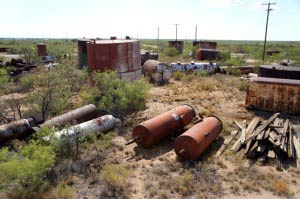The dirt roads of Penwell, Texas, criss cross overgrown lots littered with the detritus of a bygone oil boom that petered out in the 1940s. But as early as next summer, this ghost town 16 miles southwest of Odessa will become the site of a new coal power plant facility––funded in large part by taxpayers––that could play a major role in not only helping prolong the life of a dying coal industry, but in fueling an oil boom that’s just getting started in the Permian Basin region of West Texas.
The Texas Clean Energy Project (known as TCEP) is a proposed coal gasification plant that will generate electricity while attempting to capture 90 percent of the carbon dioxide emitted in the process. That’s according to Summit Power Group, the Seattle-based company behind the project.
TCEP is one of four U.S. power plants in the planning stages that would use Carbon Capture and Sequestration technology, which comes with an unproven track record and an exorbitant price tag for taxpayers…not to mention the impacts of mining the coal in the first place. A fifth such plant is already under construction in Mississippi.
Rather than diverting CO2 emissions into permanent storage as the technology’s name implies (a risky venture in its own right), four out of the five plants would repurpose the captured gas for use in oil extraction — that is, to help extract more carbon out of the ground. Petroleum companies in Texas are lining up to buy Summit’s CO2 and inject it into declining oil fields where it will act as a lubricant and a source of pressure, forcing more oil to flow into the wells there.
The process of using CO2 to coax more oil from old wells is called Carbon Dioxide Enhanced Oil Recovery, or CO2-EOR. In other words, the Texas Clean Energy Project is a power plant that, once operational, will burn coal and then sell its emissions to allow for the extraction of hard to reach oil, which in turn will be refined and burned.
This paradoxical strategy of capturing carbon emissions only to unearth more fossil fuels has made its way to the forefront of the federal government’s plans for tackling climate change, thanks in part to support from a plethora of industries whose pollutive practices would be threatened by a widespread shift to renewable energy.
But the biggest financial supporters of CO2-EOR are taxpayers. Since 2008, Congress has allocated $6 billion to research and development of Carbon Capture and Sequestration technologies. And yet its taxpayers who are impacted by the continued mining of coal, the effects of burning more oil, and the dangers posed by extreme fossil fuel extraction methods, like fracking, with which CO2-EOR is interconnected.
Through grants, tax breaks, and loan guarantees, the public is paying the financial costs––while shouldering the consequences––of re-shaping the carbon cycle to justify the continued use of dirty fuels and dangerous methods under the auspices of mitigating climate change.
Cashing in on carbon
There are several ways that taxpayers foot the bills for a project like the Texas Clean Energy Project, according to a report by Oil Change International, Cashing in on All of the Above: U.S. Fossil Fuel Production Subsidies Under Obama.
In 2011, $587 million in federal funding was allocated to research and development for projects that included enhanced oil recovery, carbon capture and sequestration, and coal fuels. In 2013, companies took advantage of $400 million in tax credits for investment in so-called “clean coal” facilities (of course, the “clean coal” moniker is one that’s been debunkedtime and again). That same year, $60 million went towards CO2-EOR, and oil companies were allowed $7 million in deductions for the costs of “fluids, gases and other chemicals used for enhanced oil recovery.”
For its part, Summit has received a $450 million grant from the Department of Energy and $600 million in tax breaks, mostly in the name of the still unproven carbon sequestration. But because that proposed sequestration goes hand-in-hand with enhanced oil recovery, some 47 percent of the CO2 injected into the ground by the project will likely be released when the petroleum it helps to extract is burned for fuel, according to the Energy Justice Network.
Summit will be among the first to sell industrially produced CO2 for the purpose of enhance oil recovery. The company is poised to meet a high demand; the market for CO2 has ballooned as the result of a recent oil boom spurred by the All of the Above Energy policy and the increased use of hydraulic fracturing technology, or fracking.
Since 2007, oil production in the region has doubled from roughly 800,000 barrels per day to over 1.6 million. It’s currently the highest producer in the country, just ahead of the Bakken oil field in North Dakota and Eagle Ford in East Texas––both hotbeds of fracking activity.
A pumpjack on every block and a flare every half mile
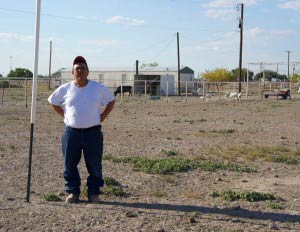 Hector Rodriguez stands next to a stake that workers from Linn Energy drove into the middle of his property. It marks the spot where there may one day be a fracked well. (Credit: Anna Simonton)Hector Rodriguez lives in Gardendale, an unincorporated suburb of Odessa once known for its pecan orchards. He bought six acres there in 2006 and made his home in a trailer house, with the eventual goal of building a five bedroom home for himself and his family. He acquired a couple of cows, a few sheep, and started a small dog breeding operation to supplement his salary as a technician for an oil company.
Hector Rodriguez stands next to a stake that workers from Linn Energy drove into the middle of his property. It marks the spot where there may one day be a fracked well. (Credit: Anna Simonton)Hector Rodriguez lives in Gardendale, an unincorporated suburb of Odessa once known for its pecan orchards. He bought six acres there in 2006 and made his home in a trailer house, with the eventual goal of building a five bedroom home for himself and his family. He acquired a couple of cows, a few sheep, and started a small dog breeding operation to supplement his salary as a technician for an oil company.
Then, in December 2012, workers from Berry Petroleum (now Linn Energy) showed up and planted a stake 175 feet away from his trailer. Rodriguez knew what it meant. The company had been leasing mineral rights from an out-of-town investor and fracking in the backyards of Gardendale residents, most of whom only own the rights to the surface of their property.
The stake on Hector’s land was at the epicenter of what could become a three acre drill pad, though Berry/Linn representatives told him they weren’t sure if they would actually drill there. Regardless, they told him he couldn’t build anything on those three acres.
“They don’t have a permit or anything, but I can’t afford to take them to court,” Rodriguez says. “I’m paying taxes on land I can’t use. And I can’t sell it because it’s not worth anything with that stake on it. I’m stuck.”
 Linn Energy leaves chemical-laced frack water in open pits to evaporate, leaving behind contaminated sludge in residents’ yards. (Credit: Anna Simonton)Rodriguez is now the president of the Gardendale Accountability Project, a community group that has closely documented the transformation of their neighborhood into what almost resembles a themed town. But instead of inauthentic Dutch architecture or a proliferation of fiberglass sculptures, there’s a pumpjack on every block and a flare every half mile, burning off gases released by fracking.
Linn Energy leaves chemical-laced frack water in open pits to evaporate, leaving behind contaminated sludge in residents’ yards. (Credit: Anna Simonton)Rodriguez is now the president of the Gardendale Accountability Project, a community group that has closely documented the transformation of their neighborhood into what almost resembles a themed town. But instead of inauthentic Dutch architecture or a proliferation of fiberglass sculptures, there’s a pumpjack on every block and a flare every half mile, burning off gases released by fracking.
A subtle, headache-inducing chemical odor permeates the air. Sometimes the smell is stronger, sour, and eggy. That signals an excess of hydrogen sulfide, or H2S, an extremely toxic natural gas.
On one occasion, so much H2S was released from a flare that nearby residents were evacuated from their homes. Another time, a flare stack fell over, shooting fire and billowing thick black smoke. The oil company’s first responder didn’t have the code to unlock the gate surrounding the toppled flare, so a member of the Gardendale Accountability Project unlocked it for him. (Members of the group with flares on their property had separately requested the codes to their gates from Berry/Linn and found they were all the same.)
 The sand on this drill pad is mysteriously discolored, possibly from a chemical spill. (Credit: Anna Simonton)At the home of an elderly couple––themselves also members of the Gardendale Accountability Project––a pile of rubble as tall as their one-story house obscures from sight the two acres where they once grazed a few horses and longhorn steer. Now it’s a drill pad, where an open pit contains black sludge––what’s left of the flowback, which is the chemical-laced water that comes back up from the well during fracking. Rather than spending the money to truck the contaminated water away, Linn Energy allows it to evaporate in these pits, then fills them in with dirt.
The sand on this drill pad is mysteriously discolored, possibly from a chemical spill. (Credit: Anna Simonton)At the home of an elderly couple––themselves also members of the Gardendale Accountability Project––a pile of rubble as tall as their one-story house obscures from sight the two acres where they once grazed a few horses and longhorn steer. Now it’s a drill pad, where an open pit contains black sludge––what’s left of the flowback, which is the chemical-laced water that comes back up from the well during fracking. Rather than spending the money to truck the contaminated water away, Linn Energy allows it to evaporate in these pits, then fills them in with dirt.
In the middle of the pad is the well itself, with a meter counting the number of barrels flowing into a tank. On the other side of the well, the sand on the pad is bright pink and yellow. No one knows what it is, but Rodriguez suspects a chemical spill. At the edge of the pad, a fence separates the couple’s property from their daughter’s, where the animals now reside. One of the horses recently recovered from an allergic reaction that caused welts to form all over its body.
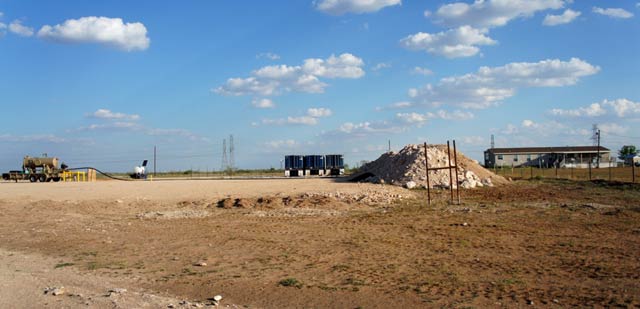 A wall of rubble stands between a Gardendale house and the yard where the homeowners once grazed animals. Now the yard is a drill pad with a fracked well. (Credit: Anna Simonton)
A wall of rubble stands between a Gardendale house and the yard where the homeowners once grazed animals. Now the yard is a drill pad with a fracked well. (Credit: Anna Simonton)
Rodriguez says the majority of Gardendale residents, as well as people throughout the Permian Basin, have stories like these or fear that they one day will. But so many are employed by the petroleum industry that only a minority has spoken out.
“Oil is our bread and butter,” Rodriguez explains. “It feeds our families and pays our bills. People are scared to talk against it. But we don’t know what fracking does to the environment. When it comes down to it, we can live without oil. Can we live without water? Can we live with these health problems? No.”
How to win tax breaks and influence the DOE
Summit’s CO2 may or may not find its way to Gardendale, but regardless it will perpetuate the boom that has overtaken the Permian Basin. And as technology advances, CO2 may one day replace water in some fracking processes entirely. General Electric has partnered with a Norwegian company on a $10 billion research project to this end.
GE and Summit’s shared interest in CO2-EOR is made explicit by their mutual participation in an organization called The National Enhanced Oil Recovery Initiative (NEORI). The multi-billion dollar company Arch Coal and agribusiness giant Archer Daniels Midland also have representatives in NEORI, along with leading gas companies, state officials, regulators, and environmental representatives.
The group first convened in 2011 and developed recommendations including a new federal tax credit for industrial producers of CO2, and the expansion of an existing federal tax credit for carbon sequestration and enhanced oil recovery, known as 45Q.
In May, Senator John Rockefeller of West Virginia introduced a bill, the Expanding Carbon Capture Through Enhanced Oil Recovery Act of 2014, based on NEORI’s recommendations.
Senator Rockefeller has a personal stake in the legislation––his campaign committee has received a combined $84,000 from PACs and employees of Arch Coal, GE and Archer Daniels Midland.
But he’s not the only one. According to Maplight, interest groups that support the bill hold considerable sway over Congress, having contributed a total of $14,970,343 to U.S. Senators since 2008. Those include environmental policy groups, as well as chemical, coal, and oilfield servicing groups.
The Center for Responsive Politics’ Open Secrets database shows that Summit alone has spent $830,000 lobbying for the expansion of 45Q and other legislation related to their projects, including an amendment to a Department of Energy program that awarded the Texas Clean Energy Project its $450 million grant.
In addition to influencing lawmakers, Summit enjoys a cozy relationship with the DOE. The company’s founders, Earl Gjelde and Don Hodel both held high-ranking positions within the DOE and the Department of the Interior under the Reagan administration.
So, it’s not surprising that TCEP and other CO2-EOR projects are gaining ground despite their dubious ability to actually curb the climate crisis and the risks they pose to the communities stuck in their path. There’s money to be had afterall.
According to NEORI, the proposed reforms would generate billions of dollars in revenue through oil royalties, while storing more than four billion tons of CO2 underground over 40 years.
But how much more CO2 would be emitted into the atmosphere throughout the entire life cycle of the CO2-EOR process is unclear. Nor does NEORI’s vision address the devastation that marks the beginning of the CO2-EOR cycle––in coal country.
Dried up springs, dirty coal mines, massive subsidies
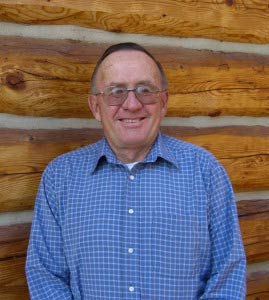 LJ Turner at his Wyoming ranch home. (Credit: Karen Turner)When LJ Turner’s family came to the Powder River Basin region of Wyoming as homesteaders in 1918, people told them of a particular clean water spring that was “foolproof.” The Turners chose to settle around that spring, understanding that they would have a reliable water source for generations to come. Now the spring is permanently dry, and Porcupine Creek, the other main water source on Turner’s 10,000 acres, has dried up twice in the past two years.
LJ Turner at his Wyoming ranch home. (Credit: Karen Turner)When LJ Turner’s family came to the Powder River Basin region of Wyoming as homesteaders in 1918, people told them of a particular clean water spring that was “foolproof.” The Turners chose to settle around that spring, understanding that they would have a reliable water source for generations to come. Now the spring is permanently dry, and Porcupine Creek, the other main water source on Turner’s 10,000 acres, has dried up twice in the past two years.
The culprit? Thirteen coal mines, the nearest only ten miles from Turner’s ranch, that use millions of gallons of water from the region’s aquifers.
Over the past three decades, coal production in the Powder River Basin has grown to supply 40 percent of the nation’s coal. According to the Powder River Basin Resource Council (PBRC), these mines are the root cause of 13 percent of carbon dioxide emissions in the U.S., making them the nation’s single greatest contributing factor toward climate change.
Taxpayers bear not only the social and environmental costs of coal mining, but also lose revenue from the federal government leasing public land to coal companies for below-market rates. According to Cashing in on All of the Above, this discount amounted to $1 billion in 2011.
Turner once leased public grasslands for grazing livestock, but had to sell his commercial cattle herd after losing 6,000 acres to the mines. Now he has only a purebred herd for breeding, and has reduced his flock of sheep by two thirds.
“When they first came in, they told us how great the land would be after reclamation,” he says, referring to regulations requiring coal companies to re-vegetate mined land and restore aquifers. “But our cattle have never had a mouthful of reclaimed grass.”
According to the PRBRC, coal companies have restored less than four percent of the lands that are no longer being actively mined.
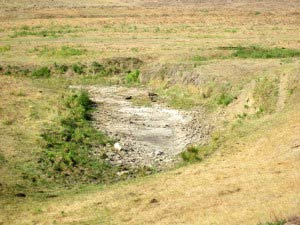 This spring on LJ Turner’s ranch used to have water year round. Now it dries up in the summer because the nearby North Antelope Rochelle Mine has drawn down the water table. (Credit: Karen Turner)Changes to the landscape have taken a toll. Turner has hunted antelope since he was a boy, but now the herd has disappeared. There are no more barn swallows or magpies, no more frogs which used to overrun the creek.
This spring on LJ Turner’s ranch used to have water year round. Now it dries up in the summer because the nearby North Antelope Rochelle Mine has drawn down the water table. (Credit: Karen Turner)Changes to the landscape have taken a toll. Turner has hunted antelope since he was a boy, but now the herd has disappeared. There are no more barn swallows or magpies, no more frogs which used to overrun the creek.
Besides the threat coal mining poses to his livelihood and the land he loves, Turner worries about the health impacts. One of his relatives who worked with blasting powder died of cancer at the age of 43. The man’s boss had died of the same cancer only one year before.
“You look at the obituary pages around here and see so many people who are far too young to have these kinds of health problems,” Turner says. His doctor closely monitors his respiratory health, since coal dust that hangs in the air for miles around the mines has caused breathing problems for many of her patients.
That sooty dust will spread along the route a coal train takes as it carries the commodity from the Powder River Basin to the Texas Clean Energy Project sometime next year.
From the Wyoming coal mines, to the gasification plant in Penwell, to the oilfields of the Permian Basin and into the atmosphere, Summit’s CO2-EOR is an experimentation with a new carbon cycle that raises as many questions as it answers. But one thing is certain: however things pan out, the public is paying for it.
